The United Nations Sustainable Development Goals (SDGs) act as a blueprint to attain a better and a more sustainable world. They aim to address the global challenges, including poverty, injustice, gender inequality, climate change, and environmental degradation. In the pursuit of sustainable development, countries across the globe are devising strategies to accelerate the attainment of SDGs. Effective SDG implementation entails robust institutional set-ups, inclusive stakeholder coordination, interlinked synergies in conjunction with strong monitoring and evaluating systems.
Figure 1: Agenda 2030 and Sustainable Development Goals

Source: United Nations Development Program, 2022
Under the SDG framework, all the countries are encouraged to review the progress of SDG implementation at the national and at the sub-national level. The Voluntary National Reviews (VNR) aim at enabling sharing of experiences, including success stories and lessons learned amongst various countries. VNRs exhibit a country’s stand on SDG implementation and attempt to accelerate SDG progress through peer-learning, sharing of experiences, identifying gaps and the best practices, and generating partnerships. Against this background, this paper examines institutional set-ups along with thematic best practices from the VNRs of various countries from 2018 onwards. This reflection on the best practices of SDG implementation by various countries can serve as a guide for the Sustainable Development Goals Coordination Centres (SDGCCs) in India. It can contribute to the states who are in the process of fast-tracking their SDG implementation process.
1. Institutional Setups
This section discusses the institutions and mechanisms of various countries, that take decisions on the SDGs. It further encompasses mechanisms for inter-ministerial and multi-sectoral synchronization that involves congruity at multiple tiers of the government.
1.1 Decision Making and Coordination Mechanisms on the SDGs
A large number of countries have inter-ministerial committees to facilitate coherence and coordination in the implementation of the SDGs. These committees demonstrate the concentration of the countries on cross-sectoral collaboration and policy integration. For example, Finland has a strong institutional set-up for sustainable development which involves the existing government structures along with the National Commission on Sustainable Development. Finland has a very comprehensive SDG architecture that has helped the country to be at the forefront of many international sustainability studies.
Figure 2: Correlation of the Objectives Set in the Society’s Commitment with the SDGs and Adopted by Finland’s National Commission on Sustainable Development
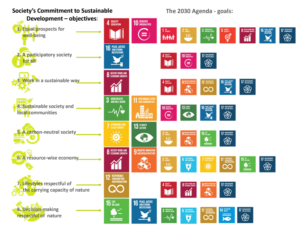
Source: Government Report on the Implementation of the 2030 Agenda for Sustainable Development, 2017
Many countries have multi-stakeholder mechanisms that take into consideration an inclusive society approach. This is generally a three-tier approach where the first tier consists of the visions, strategies, policies, and national frameworks at a broader level. The second tier typically concerns the capacity-building framework of implementing institutions and coordination and amongst various government ministries and agencies. Further, the third tier coordinates the technical work amongst the associated members, including government and non-government actors. For instance, Lebanon has established a national committee to supervise and guide the implementation of the SDGs in the country. The committee is chaired by the Prime Minister and consists of 50 state officials at the director-general level. This aids in facilitating the continuation of work irrespective of the political developments going on in the country. The committee also includes non-state actors and private sector representatives. The inclusion of civil societies and private sector representatives helps in promoting a more inclusive and participatory approach that can create more involved and conscious citizens. Along with this, the national committee has four thematic groupings that are organised based on ‘5Ps’ (People, Planet, Partnerships, Prosperity, Peace, justice, and strong institutions). The ‘5Ps’ are significant in implementing and in achieving the SDGs as the emphasis is on structures that have integration, coordination, coherence, and multi-sectoral involvement as their paradigm. A multi-level mechanism has a backup of all the stakeholders at a broader level which is central for good coordination and oversight of the SDG implementation. A tiered approach can be seen in Ghana as well. According to the VNRs of Ghana, their progress on Millennium Development Goals (MDGs) was hampered because of weak coordination at the inter-sector and intra-sector levels. As a result, to realize the power of an effective institutional mechanism, Ghana established SDG-specific structures, that consist of a High-Level Ministerial Committee, an SDGs Implementation Coordination Committee, a Technical Committee, and a Civil Society Organisation Platform on SDGs. This setup facilitates decentralised planning system and fosters effective stakeholder coordination.
A multi-sectoral engagement mechanism has been put in place in many countries. This is to ensure a robust association and engagement mechanism with the stakeholders in implementing and evaluating the SDGs. The government of Bangladesh has taken the initiative of collaborating with the NGOs (Non-Governmental Organisations) through an SDGs Implementation Sub-Committee by the NGO Affairs Bureau. The role of the civil society sector is important in achieving the SDGs, and hence, it is crucial to steer them to make visible contributions in productive SDG implementation.
Another notable institutional set-up is of Palau where the 17 SDGs have been divided into 8 SDG Working Groups. Each Working Group is led by a governmental ministry and includes representatives from the development and civil society sector. This setup is acknowledged for working towards aligning the national development framework along with the UN SDGs.
Furthermore, some institutional set-ups are based on country-specific priorities. For example, institutions in Greece have recognized the importance of strategies that focus on resolving the pertinent challenges of unemployment, gender inequality, and social inequality in the country. Greece reports that it takes measures in accordance with these challenges which are concerned with the SDG agendas as well, through measures such as, establishing a minimum guaranteed income for all and creating a strong social solidarity system.
The mechanisms also include high-level entities that make political decisions on the SDG implementations by aligning the visions of the country. For instance, in Latvia, the Cross-Sectoral Coordination Centre (CSCC) is an institution at the central level that is responsible for the development planning system of the country, and the CSCC has been designated as the pivotal point for the SDGs. The CSCC is responsible to evaluate the significance of certain SDGs for Latvia. This setup aids in realizing the priorities of the country and identify the major gaps that need to be addressed to help the country make progress towards achieving the SDGs.
The 2018 VNR of Hungary states that the country has founded the Office of the Ombudsman for future generations that advocates the interests of the future generations. The office is responsible for protecting the constitutional rights of the people, such as the right to a healthy environment, the right to preserve physical and mental health in alignment with sustainable development, and protecting the environmental and cultural heritage of the country. The introduction of this Office aids in instilling a strong sense of belongingness amongst the community for the environment by creating collective consciousness within the people.
As above-mentioned, there are some countries that have established new mechanisms for SDG decision making and implementation, however, some countries have attempted to incorporate the SDG implementation into their prevailing structures. For example, in the United Kingdom, SDGs are integrated into the Single Department Plan of each government department. Though this helps the government to focus its efforts on important issues, but in the contemporary world, it is becoming important to have institutions across the government and beyond for the SDG implementation in a country. This is mainly to ensure multi-sectoral communication and systematic SDG implementation.
1.2 Coordinating Mechanisms at Multiple Levels of Government
The VNR reports of many countries state the importance of decentralisation and vertical integration in the effective implementation of SDGs at the national and sub-national levels of the government. Coordinating mechanisms at multiple levels of the government assume utmost importance in countries that have a federal system. In this view, the local governments align their development intervention plans with the agendas of the SDGs.
In Spain, the Federation of Municipalities and Provinces has been recognized. This Federation plays an important role to devise strategies for SDG localisation. The step to consider the interests of the local governments can prove to be fruitful to establish a sense of commitment for a participatory sustainable development within the diverse commitments and mandates of the governments. For SDG localisation, a similar structure is being used in the Philippines. The country is facilitating SDG localisation through regional development plans that prioritise local strategies. Through this, the SDGs are integrated into the local programs of the country which assist in the accelerated progress of the SDGs.
Vietnam has an Inter-Sectoral Working Group on SDGs which is a part of the larger institutional arrangement for SDGs at the national level. This Group contains ministries, sectors, and organisations to aggravate the implementation of the National Action Plan and SDGs. This helps in advancing the coordination system in the country which is key for the effective implementation of the SDGs. Local governments can play a significant role in the SDG implementation process through attempting local means of implementation, monitoring, and evaluation programs.
Figure 3: Institutional Arrangement for SDG Implementation in Vietnam
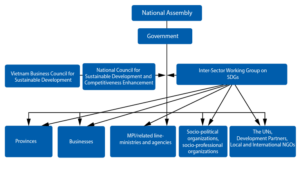
Source: Vietnam’s Voluntary National Review, 2018
1.3 Involvement of Parliaments
Parliaments play an important role in the effective implementation of the SDGs through their legislative functions and budget allocation policy. Many VNR reports state the active involvement of parliaments in establishing committees on the SDGs. For example, in Latvia, the parliament created a Sustainable Development Commission that promotes new policy initiatives by working with all the stakeholders. It provides a public platform to review proposals on promoting sustainable development by highlighting the research and practices of the stakeholders involved. The integration of the different stakeholders through this practice helps in the capacity building and awareness generation of the participants.
The Chadian parliament has established a special Commission with the aim of monitoring the implementation of SDGs. For the purpose of self-assessing the implementation of SDGs, the UNDP and Chadian parliamentarians developed an action plan for the years 2019 and 2020. This setup can contribute substantially in identifying the legislative gaps and can help in propagating new legislative frameworks to enable SDG implementation.
There are some countries where the parliamentarians have become members of the SDG coordination entities. For example, in Benin, the parliament representatives are associated with the steering committee of SDGs. This step can result in a higher level of compliance by the parliamentarians as it increases their operational accountability.
To achieve the SDGs, it is significant for the parliaments to proactively engage in the implementation process. In this light, United Kingdom has a system to carry out a number of inquiries on the SDGs. These inquiries include Committees on environmental audit, international development, and women equality. This aids in bringing together the parliamentarians to discuss and promote the SDGs which further facilitates impactful SDG implementation.
1.4 Audit Institutions
Further, the Auditor General’s Department of Jamaica has undertaken a practice wherein an audit of the country’s preparedness for implementation of the SDGs is taken. This audit seeks to monitor the institutional and coordination arrangements in the country for SDG implementation, oversee the resource allocation towards priority public challenges, and monitor the progress of the goals. In this context, it can be congregated that Jamaica has a thought-provoking set-up that can facilitate improved tracking and reporting of the expenditure and progress of SDGs to the parliament. Auditing institutions can add value to the whole implementational process of SDGs by identifying the loopholes in the SDG implementation framework of a country.
Figure 4: Jamaica’s National Preparedness for SDG Implementation, 2018
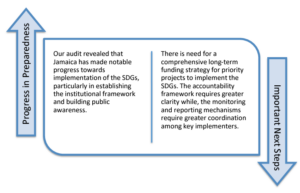
Source: Performance Audit Report, Jamaica’s Preparedness for the Implementation of SDGs, 2018
2. Thematic Best Practices
This section discusses the best practices of various countries in connection with the SDGs. It looks at the interventions that can become lessons for other countries to intensify the attainment of SDGs. As discussed below, the thematic best practices of various countries are segregated into seven sections.
2.1 Integrated Planning and Implementation
An integrated approach is important for the implementation of SDGs as it helps the governments to take advantage of the interconnectedness and co-benefits among all the SDGs. There are a number of countries that have focussed on the integrated nature of the SDGs and have realised the importance for policymakers to work across sectors and ministries. For example, Bhutan has developed SDG interventions within the context of their “Gross National Happiness” (GNH) efforts. The GNH Commission is also serving as the High-Level SDG Committee. This approach reflects the orientation of the Bhutan government towards realising the benefits of the interlinkages among many SDGs.
Figure 5: Indicators of Gross National Happiness Index in Bhutan
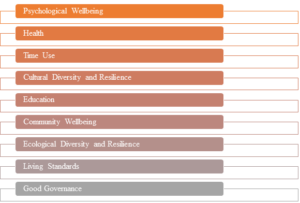
Source: Oxford Poverty and Human Development Initiative, 2022
The Australian government has kept its focus on “Health in All Policies,” by considering economic, social, and environmental determinants of health challenges. By this approach, the country can be better equipped to identify the trade-offs that may arise due to the policy intervention to develop one SDG and its negative impact on any other SDG domain. It cannot be denied that the approach to address the cross-cutting issues of human health and environmental health is the need of the hour.
The government of Gambia has established a Planners Forum that brings together the central, state, and local governments on one platform to review planning and implementation of the policies and interventions concerning SDGs. This measure is a good step to have an integrated policy formulation by promoting synergies in across-sector policies.
2.2 Research and Publications
Research and Publications help in creating novel information that is required for collective actions towards SDGs. In this light, South Africa released “Statistics South Africa,” which is the country’s SDG Indicator baseline report. It covers tier 1 and tier 2 indicators and attempts to measure the indicators to assist the governments and other stakeholders to assess the status quo of SDGs and take further measures to achieve them.
Moldova rolled out a report that presented the views of the youth on SDG adoption and implementation. This report was a result of the “Youth for Sustainable Development Goals” campaign that also awarded 17 SDG ambassador awards to the youth population. This measure also outlines the awareness generation steps of the country for SDGs.
2.3 Monitoring and Dashboards
Effective follow-ups and reviews of the SDG implementation aid the governments to make informed decisions to enhance the mechanisms put in place for SDGs. The review of the VNR reports demonstrates that countries have attempted to make substantial efforts in monitoring and assessing the data for SDGs. In this regard, Uruguay has an integrated approach. The Office of Planning and Budgeting is responsible for monitoring and developing public policies on the SDGs, and the National Institute of Statistics oversees the matters related to elaboration and survey of indicators. This approach to develop national statistical systems to monitor the progress of SDG implementation is crucial to strengthen the capacities for monitoring and evaluation of the SDGs.
One notable initiative in the domain of monitoring that can be seen is that of Jamaica. It conducted a Women’s Health Survey that provided the data on the violence against women. This initiative was one of its kind in the Caribbean region to support the monitoring of the global normative commitments under the SDGs.
Figure 6: National Lifetime and Current Prevalence by Type of Violence and Abuse in Jamaica, 2016
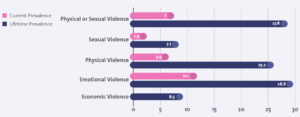
Source: Women’s Health Survey, 2016
Estonia uses an innovative data visualization tool, which is a data-driven statistics tree that provides an overall landscape of the state of implementation of the indicators. This is a step in the right direction to increase the data availability for the policymakers to facilitate policies pertaining to SDG implementation.
In the context of online platforms, the government of Rwanda with the help of the National Institute of Statistics launched an online SDGs portal. This portal contains the latest data on the SDG indicators of Rwanda. Here, the focus is on the collection, processing, and analysis of data which can eventually help in evidence-based policymaking, which is fundamental for good policy designing and implementation.
2.4 Partnerships
Partnerships become important to mobilize support for effective SDG implementation. In this view, the Bahamas is attempting to develop a national statistical system with the aid of funds from the Inter-American Development Bank. This will strengthen the data system and the monitoring capacity of the region.
Meanwhile, Mauritius has established a National Recommendations Tracking Database in collaboration with the Office of the United Nations High Commissioner for Human Rights (ONHCR). This system facilitates the recording, tracking, and reporting of the human rights-related data and implementation of human rights recommendations in the country.
One prominent step that can be seen in the partnership initiatives is the Energy and Environment Partnership which is financed by Finland, Austria, and the Nordic Development Fund. This partnership has increased energy access to the most vulnerable populations in approximately 15 Southern and East-African countries. This measure has also helped in the creation of jobs in the clean energy sector.
Additionally, multi-stakeholder partnerships are seen to be vital for the achievement of the SDGs. Australia has a Global Action on Disability Network that brings together civil society organisations, governments, and private agencies to advance the goal of disability inclusion in sustainable development efforts. A multi-stakeholder approach in SDG partnerships can also be seen in the institutional setup of Timor-Leste. It has an SDG Working Group in which the civil society organisations, government ministries, and agencies, private sector, parliament, religious organisations, and academia are included. All these stakeholders aid the government to aggravate the SDG implementation process by effectively engaging in the consultation efforts. The need for a multi-stakeholder approach is being consistently recognised for effective coordination and diverse contributions towards the implementation and follow-up of the SDGs.
2.5 Awareness Building, Youth and Citizen Engagement
Awareness of all the stakeholders is central to achieve sustainability in all the domains like environment, societal issues, or business. Against this background, Ireland has taken up the agenda of awareness building as its strategic priority. It is creating a national SDG online platform that will function as a ‘one-stop shop’ for all the SDG information and learning. This is crucial to accelerate the awareness and consciousness pertaining to SDGs among all the stakeholders.
Several countries have seen the potential of media in the awareness generation of the SDGs. For example, Ghana has established media campaign, along with in-person campaigns, to promote the adoption of SDGs. Iceland has launched a campaign to promote the SDGs through television, social media, cinemas, newspaper advertisement, and online advertising. The role of media in generating the awareness of SDGs can be massive to reach out to large population masses.
Figure 7: In-Person Campaigns in Ghana
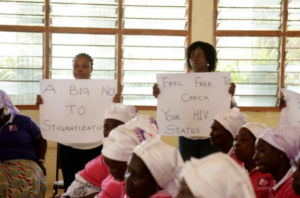
Source: The SDGs in Ghana, 2017
Along with this, many countries are also stressing the importance of engaging the youth of the country to generate awareness and drive the progress towards SDG implementation. In this regard, in Australia, universities have included SDGs in their strategic plans and curriculums. Over and above, to engage the youth in the SDG awareness programs, Lesotho has rolled out a National Youth Policy with the aim to generate awareness amongst the youth and recognize their responsibilities in the SDG implementation process.
2.6 SDG Localisation and Capacity Building
The VNR reports show that many countries have devolved power to their local governments to implement the SDGs. For instance, Estonia has highlighted its plan to promote the administrative and economic capacities of its local governments. This will not only help in the capacity building of the local authorities but will also aid the country towards SDG localisation.
In Mexico, under the guidance of its national government, the local and regional governments have shown ambitious plans and developed responsive policies to foster local planning and integration of the marginalised sections in the implementation of the SDGs. Oaxaca, a southwestern city in Mexico, has set a good example for SDG localisation practices. Here, local action is being taken with a significant emphasis on encouraging citizen involvement through the establishment of 547 Municipal Social Development Councils. For the implementation of participatory local planning pilot projects in ten municipalities, a handbook for Municipal Sustainable Development Plans has also been created. Moreover, to align the local development plans with the global goals, local indicators were developed in Mexico.
Figure 8: UN Volunteers with the Indigenous Youth of Mexico

Source: UN Volunteers, 2017
Capacity Building is another means for effective implementation of the SDGs. Countries in their VNR reports mention capacity-building initiatives on data, statistical capacity, monitoring, and evaluation. However, there are some countries whose work is prominent in the domain of capacity building. For example, Ireland supports the UN Women flagship program on statistics where the objective is to make every woman and girl count. This initiative can aid the country in using data and statistics to advance the goal of gender equality and help in the interventions relating to women’s empowerment.
The United Republic of Tanzania introduced a Local Climate Finance Project with the assistance of the UK Aid investments. Under this intervention, 35 climate-resilient projects have been undertaken in which training is being provided to people, especially women, to become traditional leaders. This intervention is articulated to increase capacity building in the citizens and mobilize the resources at the local level.
2.7 Innovation
Innovation initiatives contribute to accelerating the SDG implementation process. In Canada, the innovation platform Grand Challenge Innovation enables the investors to arrange new partnerships and address challenges in SDG implementation through collective action. This innovation platform has supported over 1000 programs and innovations in various regions of Canada. It has indulged in innovation programs that have helped in accelerating humanitarian actions, indigenous innovations, and health projects for underprivileged populations. This approach has helped in identifying the challenges and supporting the measures to help the most vulnerable people.
Some countries in their VNRs also highlighted the role of investing in young scientists and knowledge creation. For example, Slovenia has proposed legislation to increase and divert some budgetary resources to the research sector. This will help the young scientists to strengthen their innovation skills and motivate them to advance their research skills and capabilities.
2.8 Use of Technology
Some countries are focusing on the use of technology to drive progress towards the SDGs. For example, Australia has initiated Digital Earth Australia (DEA) that translates the satellite data into information and gives insights into the land and oceans of the country. This can help articulate and monitor public policies with regard to the SDGs.
Further, the Statistical Department in Tonga has started to use the small area estimation techniques to disaggregate data on all the islands, and this information is included in the country’s Multi-dimensional Poverty Report. This new technique has helped the country to improve the management, collection, and analysis of the data.
Cambodia has incorporated geospatial information and data into its SDG reporting process. This approach can especially be useful for policymaking in the domain of sustainable environmental practices and sustainable urban planning.
3. Conclusion
The last three years have seen huge advances in understanding the challenges of the contemporary world by the countries. The identification of these challenges helped to create plausible solutions to some of the problems by collectively understanding the need to protect and improve the conditions that make life worthwhile. The SDGs provide the opportunity to implement the measures to solve the global challenges, and against this background, it becomes important to learn from other countries through their best practice experiences, and failure lessons. It is essential that we embrace systematic frameworks for SDG implementation in order to protect the implicit contact existing between the current generations and the future generations.


